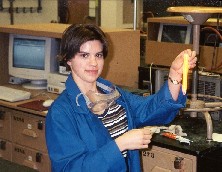



Becca is currently a TA for Chemistry 115.
Last summer, I joined a project that has been a part of chemistry at Purdue for the past three years. The project has taken many forms, but its main focus has been the of linking conceptual and algorithmic problem solving in general chemistry. The research conducted in the Summer of 2000 was guided by these two questions:
How do students use concept maps and molecular level diagrams as tools in solving algorithmic problems?
Are there critical links within a studentís conceptual understanding that appear necessary for a student to be able to effectively solve algorithmic chemistry problems?
The research was conducted in Chemistry 115/116 during the summer term. In addition to the traditional textbooks problems, homework sets that included a molecular level diagram, concept map, a simple one-step algorithmic problem, and a complex, multi-step algorithmic problem were also assigned for each of three selected topics. The topics for Chemistry 115 were stoichiometry, thermochemistry, and gas laws. The topics for Chemistry 116 were buffer interactions, kinetics, and electrochemistry.
Studentsí homework and quizzes were collected to identify critical links/ideas on concept maps and molecular level diagrams that may lead to greater success on algorithmic problems. Interviews were also conducted during the summer term. During the interview students were shown a demonstration, asked to draw a concept, molecular diagram and then solve a one step and multi-step algorithmic problems. The interviews were done to determine student perspectives in the use of concept maps and molecular diagrams as tools in solving algorithmic problems.
![]()
106 Wetherill Laboratory of Chemistry
(765) 494-6093
jardine@purdue.edu